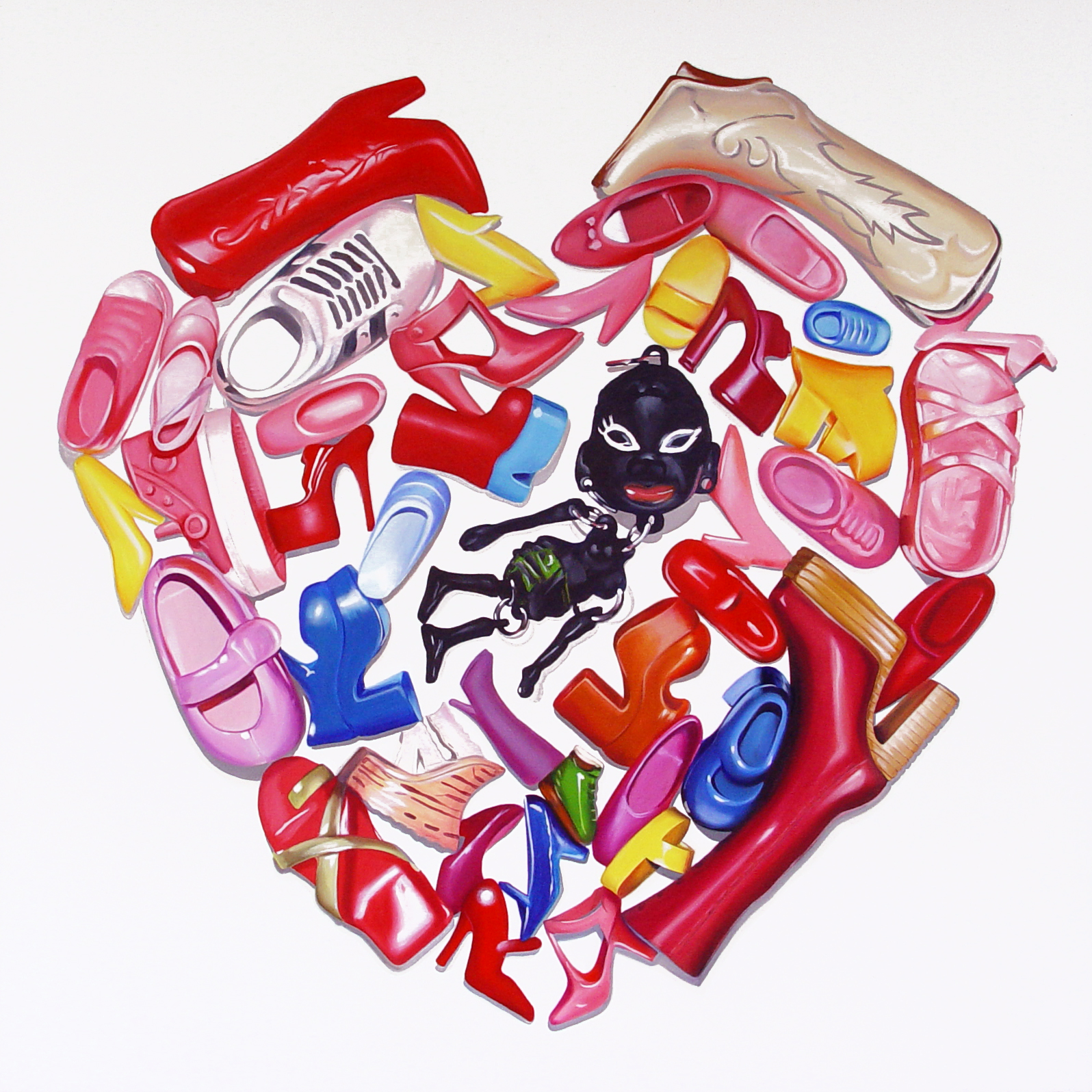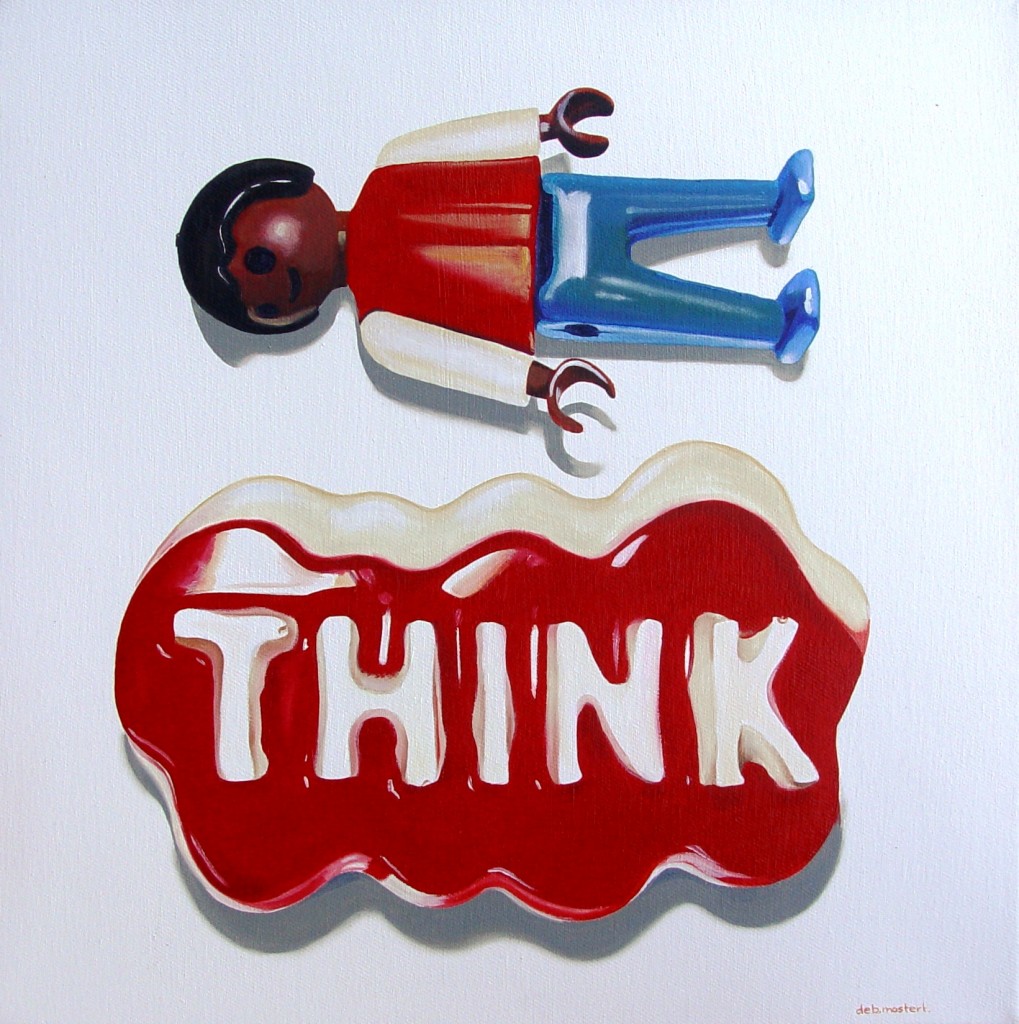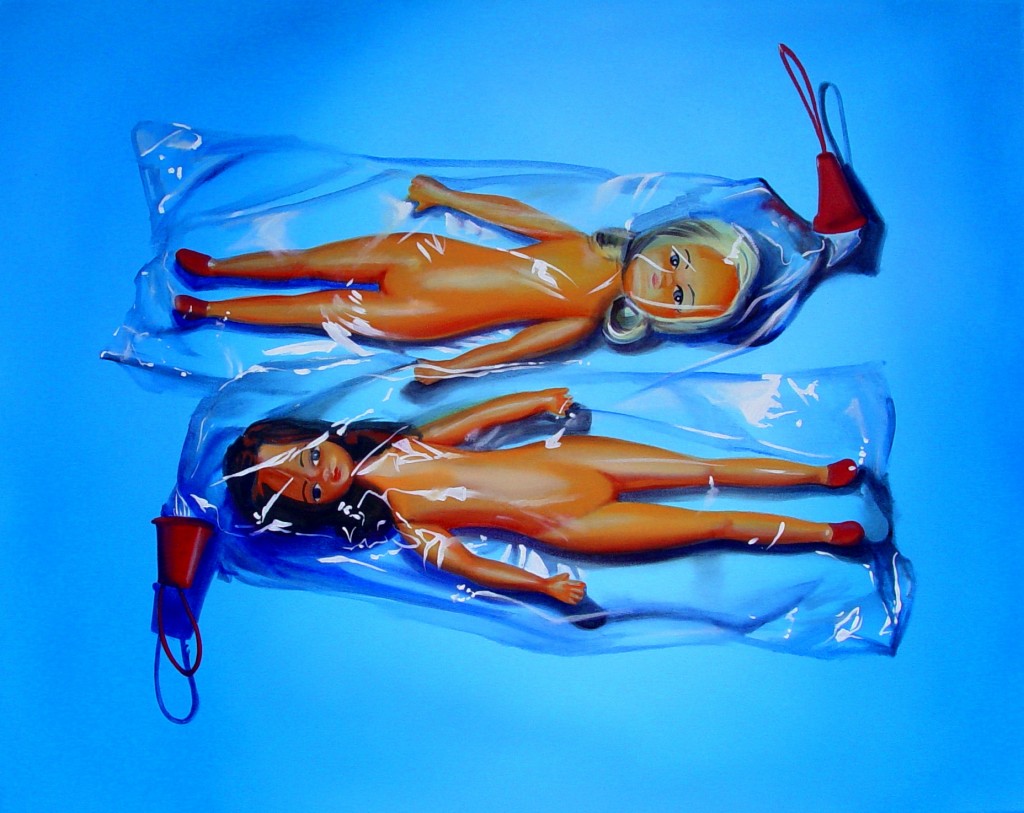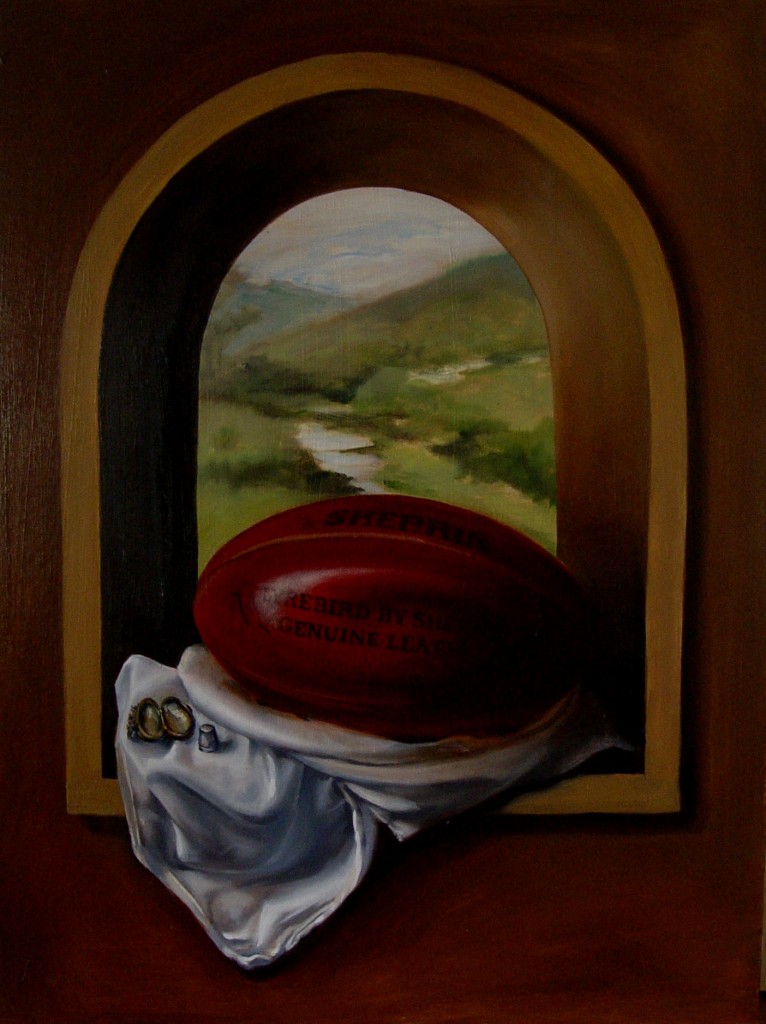Artist Deb Mostert – Lost and Found

Deb Mostert, Modern Day Slavery Plastic Dolls Shoes and Novelty Key ring, 2010, 101 x 101 cm
Art World Women asks “Does Art make a difference?”
Contemporary artist Deb Mostert brings us close to humble and ordinary objects, paying attention to the everyday from swizzle sticks to children’s toys and even bugs on cars. In a painting genre that by its very name would imply a quiet stillness, Mostert’s paintings are animated with a sense of play and joie de vivre. Traditionally a still life painter works in the solitary confines of the artist’s studio. However, in her current project Deb Mostert goes beyond the studio walls and out into the community in an effort to rebuild after the devastation of the 2011 Queensland floods.

Queensland might be almost twice the size of Texas, but in 2011, three quarters of the State was declared a disaster zone due to the floods in which many lost their lives and insurance claims are in excess of $2billion. Faced with such loss, how do people rebuild and recover? The disaster may have faded from public view as the media moves on, yet the impact still exerts itself on the people who lived through it.
Art not only reflects upon but can shape the world in which we live. Deb Mostert’s art does both. Hers is an art that listens to and honours the stories of the people who lived through the Queensland floods and helps them move on. Art World Women spoke with Deb about “still life painting” and her current project which reaches into heart and soul of her local community.
AWW: When we talk about art making a difference and creating change, it is often when an artist takes a stand for what matters to them that we see this tangible and direct impact on their communities. What has motivated you personally to undertake this body of work “The Flood Project”?
DM: We were not personally affected by water at our property but our community down the hill in Goodna was devastated and it was very distressing watching the damage done to homes, schools, business and a community of people we have been a part of for some 20 years. Also, we had many friends who were affected, flooded out or displaced. The loss of businesses as well as homes and property was a double dose for many people.
We helped out one family in particular and had people living at our home for months while homes were made habitable again. The stinking, putrefying muddy mess was overwhelming but the help from many, many hands did help make the initial clean up progress fairly quickly. What we notice however is that some people have not been able to recover or are still in the midst of the upheaval. A lot of people are not back in their homes or are too traumatized to go back. Some have only begun to process what they have lost.
AWW: As an artist, what are your aims for this project?
DM: One of my aims in doing this project is to let people know they are not forgotten by a society that tries to move on so quickly from pain and loss. The stories of loss and return, lament and redemption are uplifting, amazing, often humorous and I think worth recording. Objects are only the containers, but they do hold our memories, our recollections and our history. Most flood affected people I talk with mourn the potential loss of memories through the loss of objects, photographs, childhood drawings and mementos.

AWW: This project seems to be a natural extension from your usual work which has focussed on still life painting for some time. What is it about the “still life” genre that has captured your interest?
DM: Still life fascinates me for a few reasons. Firstly I have always been a bit of a magpie, interested in objects, scrounging and collecting in a desultory manner. From an early age I was influenced by my Uncle who is a prolific recycler (he’d make Steptoe and Son look like minimalists!) and my Aunt who is a visual/textile artist. Their home on acreage was a childhood playground of everything and anything you could ever imagine, you just had to find it! It still remains a great source of inspiration and I have made many paintings based on objects I have found at their place. I have to hold myself in check not to go out to all the sidewalk clean ups, tip shops, op shops and antique centres… I could easily become a full blown collector. (Dog figurines, old books, aluminium teapots and tin watercolour sets aside!)

AWW: Your subjects appear to be ordinary household objects and at first glance may seem as innocuous as a paper-tiger. Yet your ideas cover some serious political territory when you look a little deeper. You have explored topics such as the representations of femininity and sexualisation of young girls through your dolls in plastic bags through to highlighting the present day horror of the child slavery trade. All of this through images that seem so playful, fun and safe. Do you find that these dark and horrifying aspects of human nature are more easily discussed through toys?
DM: I guess it was the lure of these brightly coloured plastic cast off Barbie/ Brats dolls shoes and combining them with a circa 1970’s dreadfully kitsch key ring of an African female child seemed to me to make for an innocuous yet disturbing image. As always I find objects can be quietly powerful containers. Thoughts about child slavery and human trafficking become the disturbing contents. The abhorrent trade in human lives is a growing industry in our world. I’ve read that every 26 seconds a child is sold or lured into sexual slavery. In the West we give our young girls highly sexualised toy dolls to play with, yet in so many nations children have no shoes and are lured or forced into the slave trade.

AWW: The Dutch are renowned for their tradition of still life painting. How has your heritage influenced you and your work?
DM: I do have a Dutch heritage with both my parents born in the Netherlands and of course the still life tradition there is so strong. I’m proud of my roots and have visited the Netherlands and found myself resonating with the richness of the genre. I like the fact that it was and maybe still is, considered the lowest on the hierarchy of painting genres. I like the humility and banality combining with the sacredness of the everyday. On a personal level, my faith allows me to see God in all things. I am becoming increasingly aware that there is no division in my life between some things being ‘sacred’ and others ‘ordinary’. So even vintage toys and household objects can be metaphors for my spiritual journey. So often things that seem worthless and abject are at the same time, precious and valuable and still have the quiet power to contain our memories, reflect our emotions and become metaphors for important issues.
AWW: Can you share with us about your technique and approach to painting?
DM: The works start with detailed drawing. Working from life means that the objects are placed and set up under appropriate lighting in my studio on two purpose built ‘stages’. I then stick up signs to let the family know not to touch the drapery and objects as it may be many weeks before I have finished a painting! I enjoy working from life as the information gathered first hand is different to what can be gleaned from a photograph. I have worked both ways and see the benefits of both practices.
Drawing is my first love and so that is probably the part I like best….. but the painting must happen so after several thumbnail colour compositions I start to work up a loose tonal underpainting keeping things as broad as possible for as long as possible. The work builds up on top of the detailed tonal underpainting and I’m enjoying using glazes and scumbling. I’m working on gessoed masonite, the nearest affordable thing to panel and very practical. I use a mixture of Langridge, Bloxx, W&N and Art Spectrum oil paints. Brushes are expendable because I am hopeless at looking after them so I don’t buy expensive ones! I blame that on 20 years of using watercolour and not ever having to stress about washing my brushes so pedantically as when using oils.

AWW: The paintings in your flood Project have a different quality to your usual brightly lit, candy colour works. What has changed and why?
DM: It is a different way of painting to my usual style. I’ve been having classes in traditional drawing and painting techniques with Atelier Salisbury here in Brisbane. The skills I am slowly learning, I have been able to apply to these paintings as I really wanted them to have the richness and depth of the Dutch masters. Now, I’m a LONG way off having those skills in hand but the opportunity to at least try is stretching me. I love the light in those old masters works and am trying to get hints of that coming through these paintings.
AWW: Coming back to the “Flood Object Project”, how are you approaching this body of work?
DM: I am making a series of paintings based on objects which were salvaged during the 2011 floods by people in my own community of Goodna and the surrounding areas of Ipswich and Brisbane. Through personal connections, meeting and talking with people about things they have lost on the floods and managed to salvage from the mud. It is the stories of these objects that contain their memories and significance.
So the objects become symbols of the sacred, containers of grief, loss and also redemption. They become objects of hope. They are painted as modern day Dutch still life Vanitas or Flower Paintings.
AWW: By the very nature of the stories imbedded in these objects, your work really speaks of the transience of things, of loss, which is at the heart of the “Vanitas” tradition. How are you working with the community to restore hope and invigorate recovery? What has been the impact of the sharing of stories so far?
DM: I aim to record the background stories of the people and their objects in text, both for the exhibition and in catalogue form so that these narratives on what we value can be captured and shared
Still life drawing workshops will be held in conjunction with the initial exhibition at the Ipswich Art Gallery and may hopefully aid the healing process, as stories can be swapped and shared and support can be offered through connections with the various agencies available. My hope would be, that the exhibition could tour through flood affected regional areas of Queensland in an attempt to share and validate the experiences of all those people who lived through floods, often more than once. To meet people, hear their stories and maybe do some drawing with them of their own salvaged objects is something I can do to share in the losses and celebrate the hope.
Deb Mostert is represented in Queensland by Lorraine Pilgrim
and in South Australia by Peter Walker Fine Art.
Read some of the stories on The Flood Objects Pozible page. Deb Mostert’s “Flood Objects Project” can be partnered through Pozible.
Fantastic article. Love the insight into Debs artist practice, plenty to think about.
Glad you liked it Jo. Deb Mostert’s exhibition will be touring Queenlsand’s regional galleries in 2013, following the exhibition at Ipswich Art Gallery.
Wonderful. Debs visions are deep and I admire that. She gives art a lot of thought provoking images. Excellent style.
Love your work Deb. The swizzle sticks take me to my childhood. They are so special:shining and transparent, wet-weather treasure.
I think it’s great when your art can be used to help people share experiences and heal…it’s not about creating a pretty picture but often to send a message…makes it all worth while.. good on you Deb.
It’s great to hear that even in a disaster like this we can find hope by bringing the community together through art. Sometimes when we loose everything we search for something with deeper meaning. The object that initially were just man made shop bought items now hold much emotion and memories by bringing this together in an exhibition the public can experience and try to understand the impact of the floods on a deeper level. Giving us the opportunity to consider life a little more broadly.